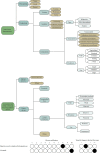Local stakeholder perceptions of forest degradation: Keys to sustainable tropical forest management
- PMID: 36369604
- PMCID: PMC9989062
- DOI: 10.1007/s13280-022-01797-x
Local stakeholder perceptions of forest degradation: Keys to sustainable tropical forest management
Abstract
Land use policies and planning in Latin America have been partially successful in halting deforestation yet have not stopped forest degradation. Here, we study the different stakeholders' perspectives of the drivers of forest degradation. We use Colombia as a case study for understanding synergies and trade-offs of the sustainable development goals (SDGs) and analyzed what the most important causes are, to whom it matters, and their regional contribution. We identified a common perception, but miscommunication and misunderstandings occur between local- and national-level actors in terms of their views on responsibilities and rates of change. The results are a call for action. Cross-scale governance is necessary to improve the design and implementation of policies for forest management at the subnational and local levels and to ensure that we move toward sustainable development without worsening existing inequalities. It is essential that countries provide the enabling conditions to develop a coherent governing framework.
Keywords: Colombia; Forest fire; Forest loss; Grazing; Logging; Trade-offs.
© 2022. The Author(s) under exclusive licence to Royal Swedish Academy of Sciences.
Conflict of interest statement
The authors have no relevant financial or non-financial interests to disclose.
Figures




References
-
- Armenteras D, Cabrera E, Rodríguez N, Retana J. National and regional determinants of tropical deforestation in Colombia. Regional Environmental Change. 2013;13:1181–1193. doi: 10.1007/s10113-013-0433-7. - DOI
-
- Armenteras D, González TM, Barreto S. Fuegos y áreas protegidas de la Amazonia Colombiana: Cambio en los motores de deforestación. Revista Colombia Amazonica. 2018;11:73–84.
-
- Armenteras, D., T.M. González, M. Meza, J.P. Ramírez-Delgado, E. Cabrera, G. Galindo, A. Yepes. 2018a. Causas de degradación forestal en Colombia: una primera aproximación.
MeSH terms
LinkOut - more resources
Full Text Sources
Miscellaneous

